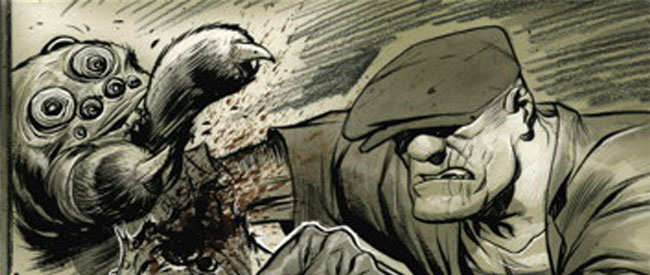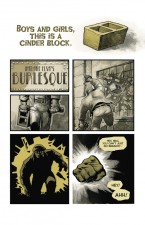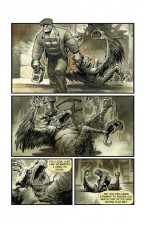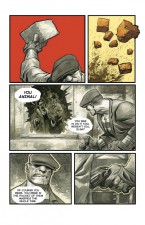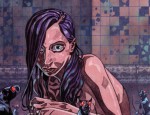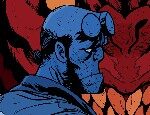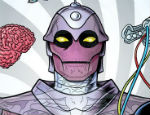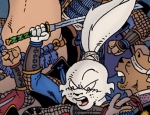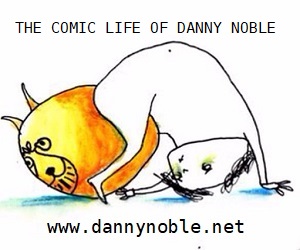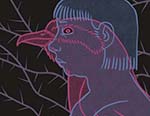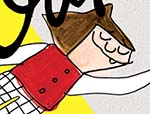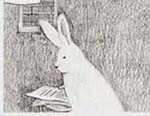The world of Eric Powell’s Goon has always been one where desperation hangs like a cloud and each victory is earned with bloody knuckles. In Once Upon a Hard Time, though, the Goon’s damned journey may finally have reached its end.
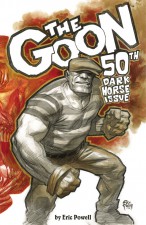 At this point, Powell’s Goon feels like an old friend—and with good reason, as this release marks 50(ish) issues and over 15 years of Depression-era mob-and-monster-mashing.
At this point, Powell’s Goon feels like an old friend—and with good reason, as this release marks 50(ish) issues and over 15 years of Depression-era mob-and-monster-mashing.
Eric Powell recently opted to streamline the book’s erratic publishing schedule by shifting to a miniseries format, starting with last year’s Occasion of Revenge. The shift has produced some of the finest work of the creator’s lengthy run. If Once Upon a Hard Time does bring this era of The Goon to an end (as Powell has stated cryptically in interviews), you can be damn sure he’s going out on top.
The Goon has faced plenty of challenges in his time, from rampaging giant lizards to kill-crazy robots. He’s managed to triumph over most without ever truly becoming a hero, if such things exist amid the gangsters and things from beyond the grave who call his (literally) cursed city home. Nonetheless, each successive story arc has revealed the moral struggle hiding behind his one good eye, starting especially with the acclaimed Chinatown graphic novel.
At the beginning of Once Upon a Hard Time #1, it appears as though that struggle has finally been decided. The Goon is on the warpath after the events of Occasion of Revenge, as destructive and unyielding as the that which initiates his revenge against the witches’ coven that plagues him.
One of the most fascinating aspects of The Goon has been watching Powell develop alongside his character. There’s no question that Once Upon a Hard Time brings out some of his strongest work yet. Art-wise, Powell’s customary blend of ink washes, pencils, and other techniques is accented by boldly colored backgrounds, wide-scale panoramic shots, and characters and objects that often threaten to break out of the confines of the panel.
The storytelling is also especially masterful here, operating on the simple maxim of “less is more.” Dialogue is terse and hard-boiled, like it always has been, but also used sparingly to convey the Goon’s fraying sense of self. Compare this to a page of Chinatown, where the dialogue sometimes threatened to overwhelm the word balloons (and thus overshadowed Powell’s gorgeous panels). Here, the art and prose are in near-perfect sync—a knife-edge balancing act of precision that complements the carnage on display.
While the Goon is front-and-center in Once Upon a Hard Time, his has always been an ensemble cast. Comrade-in-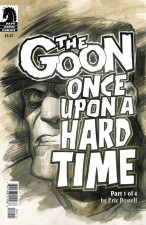 arms Franky calls the Goon’s life “one of them stage plays of comedy and tragedy,” and just as in those caricatures of reality, even the most minor of characters makes an impact as they tread the boards during what could be the Goon’s last performance. Throwaway comic relief and mortal enemies intermingle—an obvious treat for long-time readers, and an intriguing teaser for those who may be picking up an issue for the first time (for shame).
arms Franky calls the Goon’s life “one of them stage plays of comedy and tragedy,” and just as in those caricatures of reality, even the most minor of characters makes an impact as they tread the boards during what could be the Goon’s last performance. Throwaway comic relief and mortal enemies intermingle—an obvious treat for long-time readers, and an intriguing teaser for those who may be picking up an issue for the first time (for shame).
Even with big-name endings like Wolverine and the Fantastic Four in the news, by the end of this first issue, the potential finale of The Goon feels more potent than either. There may be peace at the end of the road, or subservience to the evil forces that are tightening their grips on this orphan boy all grown up. Either way, there’s bound to be plenty more blood before the final curtain drops.
Eric Powell (W/A) • Dark Horse, $3.50, February 4, 2015





